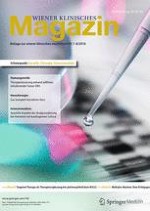Anzeige
01.04.2016 | Genetik
Ein vielversprechendes Werkzeug
Therapiesteuerung anhand zellfreier, zirkulierender Tumor-DNA
Erschienen in: Wiener klinisches Magazin | Ausgabe 2/2016
Einloggen, um Zugang zu erhaltenZusammenfassung
Durch die zunehmende Anzahl an zielgerichteten Therapien kommt es in der Behandlung von Krebserkrankungen zu einem Paradigmenwechsel. Die molekulargenetische Diagnostik und kontinuierliche Charakterisierung der Tumore gewinnt daher zunehmend an Bedeutung. In den meisten Fällen sind aber wiederholte Gewebsentnahmen eines Tumors und dessen Metastasen nicht durchführbar, weshalb eine Analyse von tumorspezifischen Veränderungen aus Blut bzw. Plasma oder Serum vorteilhaft wäre. Wiederholte Blutabnahmen sind einfach, schnell und kostengünstig zu bewerkstelligen, ohne den Patienten zu belasten. Zellfreie, zirkulierende DNA-Fragmente (ctDNA), welche von unterschiedlichen Tumorlokalisationen in die Zirkulation entlassen werden, reflektieren die Veränderungen im Tumorgenom in Echtzeit und erlauben somit eine Überwachung während des gesamten Therapieverlaufs und darüber hinaus. Unzählige Studien haben die klinische Relevanz von ctDNA als diagnostischen, prädiktiven und prognostischen Biomarker belegt. In dieser Übersichtsarbeit werden die Biologie, methodische Ansätze sowie das Potenzial der ctDNA zu Überwachung des Therapieansprechens diskutiert.
